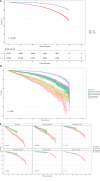Adults With Congenital Heart Disease: Trends in Event-Free Survival Past Middle Age
- PMID: 36571845
- PMCID: PMC10022672
- DOI: 10.1161/CIRCULATIONAHA.122.060834
Adults With Congenital Heart Disease: Trends in Event-Free Survival Past Middle Age
Abstract
Background: The survival of children with congenital heart disease has increased substantially over the past decades, with 97% currently reaching adulthood. The total effect of advanced treatment on future mortality and morbidity in adult survivors with congenital heart disease (CHD) is less well described.
Methods: We used data from the Swedish National Inpatient, Outpatient, and Cause of Death Register to identify patients with CHD who were born between 1950 and 1999 and were alive at 18 years of age. Ten controls identified from the Total Population Register were matched for year of birth and sex and with each patient with CHD. Follow-up was from 1968 and 18 years of age until death or at the end of the study (2017). Survival percentage with 95% CI for all-cause mortality were performed with Kaplan-Meier survival function. Cox proportional hazard regression models with hazard ratios (HRs) and 95% CI were used to estimate the risk of all-cause mortality.
Results: We included 37 278 patients with adult CHD (ACHD) and 412 799 controls. Mean follow-up was 19.2 years (±13.6). Altogether, 1937 patients with ACHD (5.2%) and 6690 controls (1.6%) died, a death rate of 2.73 per 1000 person-years and 0.84 per 1000 person years, respectively. Mortality was 3.2 times higher (95% CI, 3.0-3.4; P<0.001) among patients with ACHD compared with matched controls. Up to the maximum of 50 years of follow-up, >75% of patients with ACHD were still alive. Mortality was highest among patients with conotruncal defects (HR, 10.13 [95% CI, 8.78-11.69]), but also significantly higher for the more benign lesions, with the lowest risk in patients with atrial septal defects (HR, 1.36 [95% CI, 1.19-1.55]). At least 75% of patients with ACHD alive at 18 years of age lived past middle age and became sexagenerians.
Conclusions: In this large, nationwide, register-based cohort study of patients with ACHD surviving to 18 years of age, the risk of mortality up to 68 years of age was >3 times higher compared with matched controls without ACHD. Despite this, at least 75% of patients with CHD alive at 18 years of age lived past middle age and became sexagenerians. A notable risk decline in the mortality for patients with ACHD was seen for those born after 1975.
Keywords: adult congenital heart disease; cardiovascular morbidity; survival.
Conflict of interest statement
None.
Figures



Comment in
-
Adult Congenital Heart Disease: A Specialty With Ever-Expanding Challenges.Circulation. 2023 Mar 21;147(12):939-941. doi: 10.1161/CIRCULATIONAHA.122.063189. Epub 2023 Mar 21. Circulation. 2023. PMID: 36944037 No abstract available.
References
-
- Van der Linde D, Konings EE, Slager MA, Witsenburg M, Helbing WA, Takkenberg JJM, Roos-Hesselin JW. Birth prevalence of congenital heart disease worldwidea systematic review and meta-analysis. J Am Coll Cardiol. 2011;58:2241–2247 doi: 10.1016/j.jacc.2011.08.025 - PubMed
-
- Moons P, Bovijn L, Budts W, Belmans A, Gewillig M. Temporal trends in survival to adulthood among patients born with congenital heart disease from 1970 to 1992 in Belgium. Circulation. 2010;122:2264–2272. doi: 10.1161/CIRCULATIONAHA.110.946343 - PubMed
-
- Mandalenakis Z, Rosengren A, Skoglund K, Lappas G, Eriksson P, Dellborg M. Survivorship in children and young adults with congenital heart disease in Sweden. JAMA Intern Med. 2017;177:224–230. doi: 10.1001/jamainternmed.2016.7765 - PubMed
Publication types
MeSH terms
LinkOut - more resources
Full Text Sources
Medical
Miscellaneous

